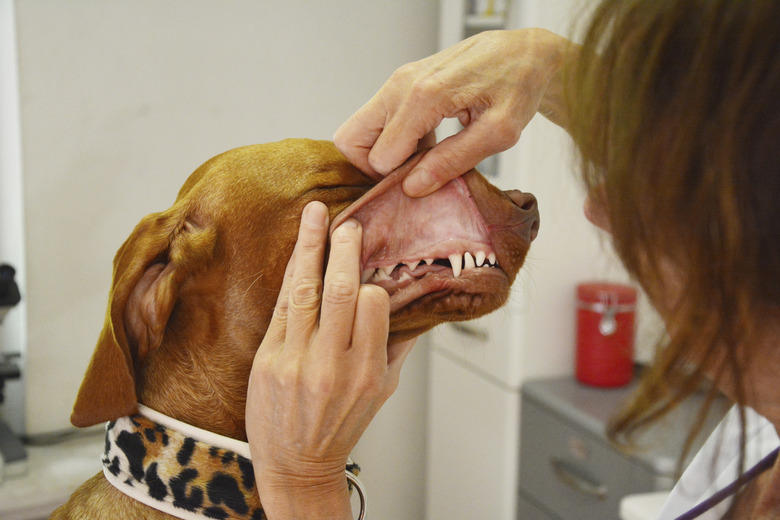Symptoms Of A Rotten Tooth With An Infection In A Dog
Like you, your dog can suffer from toothaches. Although dogs get cavities less often than humans, a buildup of tartar along the gum line can cause the gums to recede. As a result, dogs can develop periodontal infections in their carnassial teeth that lead to the formation of abscesses, which are pus pockets under the gum line. Bad breath, facial swelling, and leakage are symptoms of an infection. A rotten dog tooth is a painful condition that can cause serious illness if it is left untreated.
Carnassial tooth abscess in dogs
Carnassial tooth abscess in dogs
Although any tooth is susceptible to dental problems, the fourth premolar or carnassial tooth can cause your pup the most problems because of its size. This tooth is found on the upper jaw. It is larger than the other teeth and has three roots instead of just one. Wild dogs use this tooth to tear up large chunks of meat or bone. A carnassial tooth infection usually affects the roots of the teeth rather than the exposed area.
Symptoms of canine abscess
Symptoms of canine abscess
Symptoms indicating your pet might have an abscess include bad breath, facial swelling, and a leakage of pus that breaks through the skin of the face or mouth. Additional symptoms include tooth discoloration, oral bleeding, and an unwillingness to eat or chew anything crunchy or hard. If the infection is caused by trauma to the mouth, a broken or damaged tooth can also be visible. Your pup might also rub at his face or chew only on one side of his mouth with a rotten dog tooth.
Abscesses are often caused by a bacterial infection in the body such as streptococcus or E. coli. The bacteria infects the root and cuts off the blood connection. This destroys the tissue around the tooth and the tooth becomes loose. The body reacts to the invasion of bacteria by amassing white blood cells, which leads to the formation of pus.
Diagnosis and treatment of a rotten dog tooth
Diagnosis and treatment of a rotten dog tooth
A veterinarian can diagnose abscesses or infected teeth by conducting a physical examination and a blood test. Your dog might also need X-rays to determine which tooth or teeth are infected. The dog might need to be anesthetized to complete the examination and treatment, particularly if he is in a great deal of pain.
The doctor will drain the pus or fluid that surrounds the infected tooth. This will relieve the pressure on the root and drain the infection out of the body. The tooth is usually extracted by cutting it in half then pulling it out. The infected tissue may need to be removed as well to prevent reinfection. The tooth can also be treated with a root canal, but this process is expensive. Your pup will need to stay on antibiotics for some time after the extraction, or until the root canal is complete, to eradicate any traces of infection.
Dog teeth cleaning
Dog teeth cleaning
Prevention is often the best medicine and that's the case with a dog with rotten teeth. Chews and dental sprays designed to keep your dog's teeth clean are a good start. But more aggressive dog teeth cleaning is needed and this mean either brushing your dog's teeth at home or paying for a thorough cleaning at the vet clinic. At-home cleaning requires practice and a dog toothpaste created in flavors dogs love. Dog breeds with bad teeth (potentially), or those that are prone to periodontal disease include Bulldogs, Yorkshire terriers, and dachshunds.


